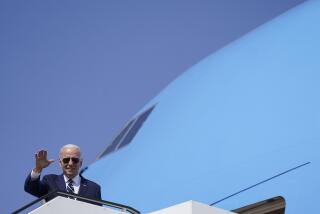India-Pakistan Nuclear Problem Eases as U.S. Official Arrives for Talks
- Share via
WASHINGTON — Two months after nuclear tests by India and Pakistan blew holes in the global scheme to control atomic weapons and raised the threat of a regional nuclear conflict, the first signs of progress toward ending the crisis have emerged.
While those involved with the issue caution that this progress is merely the first step on a long and tenuous diplomatic journey, two factors have generated a whiff of optimism:
* The constructive spirit of the first official talks between the United States and the two South Asian countries held in recent weeks.
* A new flexibility by Congress, which has suddenly backed away from a strict imposition of draconian sanctions against both countries--a stance that had undercut American diplomatic efforts to defuse the crisis.
U.S. relations with India have been especially tense since New Delhi triggered the crisis May 11 with its nuclear tests. Late last month, these ties were further strained when President Clinton released a joint statement on the South Asian crisis together with Jiang Zemin, president of India’s decades-old adversary, China.
The new sense of guarded optimism comes as Washington’s principal envoy dealing with the issue, Deputy Secretary of State Strobe Talbott, arrives in the region for talks today and Tuesday in New Delhi and Islamabad, the Pakistani capital.
He is expected to nudge both countries to accept the Comprehensive Nuclear Test Ban Treaty, to renounce efforts to develop or deploy nuclear weapons and to begin talking to each other directly about the volatile political issues--such as possession of Kashmir--that have divided them for years.
These goals, initially set out last month by the five permanent members of the U.N. Security Council--the U.S., Russia, China, Britain and France--have since been taken up by a larger group of important countries, including Brazil and Argentina, two large Latin American neighbors that renounced the nuclear option.
The success of Talbott’s trip also is expected to help determine whether Clinton follows through with earlier plans to visit both countries in November, U.S. officials said. The trip has been described as “on hold” since the nuclear tests.
If Clinton goes, it would be the first visit to South Asia by a sitting U.S. president.
One senior administration official said that unless Talbott receives assurances that Clinton could expect constructive dialogue on key issues in both capitals, the trip probably will be scrubbed.
“The president doesn’t think it would be a good idea to go halfway around the world to have backward-looking, negative discussions,” the official said.
*
Both Indian and Pakistani governments see enormous potential benefits in an American presidential visit, as much for their own domestic political prestige as in the strengthened economic and diplomatic ties that often emerge from such events. So the very prospect of a Clinton trip provides Talbott with additional negotiating leverage.
Talbott’s meetings, scheduled with Indian officials today and with Pakistanis on Tuesday, mark the third round of low-profile, yet substantive, discussions on the South Asian crisis that have been characterized by all participants as positive and encouraging.
A senior Indian diplomat familiar with the talks said he is optimistic that his nation’s security concerns can be balanced with the goals set out by the leading nations, while a Pakistani official called the dialogue a “meaningful beginning.”
“We’re basically friends, but we happen to feel they’ve made a terrible mistake,” Talbott said. “What we’re seeing now is how much common ground there is out there.”
India, for example, still refuses to sign the Comprehensive Nuclear Test Ban Treaty, in part because of a long-standing contention that the pact discriminates in favor of the world’s five declared nuclear states. However, New Delhi has reportedly offered to enter a separate, legally binding renunciation of any further nuclear testing--a step that would make India part of a global ban.
While such a step would ease Indo-U.S. tensions and lower the temperature in the region, the test ban treaty requires the participation of 44 specific nations, including India, before it goes into force.
“It’s a positive step for resolving the crisis in South Asia, but if you are looking at the global agenda for nuclear nonproliferation, it’s just not good enough,” said Joseph Cirincione, an arms control specialist at the Carnegie Endowment for International Peace, a Washington think tank.
For regional specialists, however, it signals a new flexibility on the part of both South Asian countries. For Pakistan, this flexibility stems from an economic crisis that some fear could bring the country to the brink of collapse; while for India, it is the prospect of a longer-term isolation.
“By now, these countries are getting a better flavor of the international community’s [negative] reaction,” said Robert B. Oakley, U.S. ambassador to Pakistan during the late 1980s and early 1990s. “What [Talbott] needs to do is establish a little bit of trust between them so they can begin to talk to each other directly.”
*
But it is decisions by the U.S. Senate in recent days, first to exempt American farm products from the stringent U.S. sanctions package imposed against both countries, then to grant the president the right to waive other sanctions for up to one year, that have eased animosity toward the United States and given the Clinton administration new negotiating tools.
“It gives him [Talbott] a lot more scope for potentially persuading India and Pakistan to do some of the things they need to do,” said Richard N. Haass, director of foreign policy studies at the Brookings Institution in Washington.
“It also makes it less difficult for Americans to be welcomed if the sanctions are pushed into the background.”
More to Read
Sign up for Essential California
The most important California stories and recommendations in your inbox every morning.
You may occasionally receive promotional content from the Los Angeles Times.













